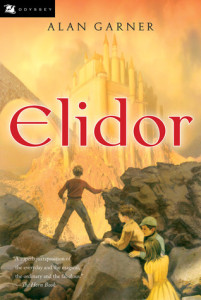 Rebecca Swain wrote this for Folk Tales, our precursor.
Rebecca Swain wrote this for Folk Tales, our precursor.
I started reading this book with the idea of skimming it for information to give when offering it to Folk Tales reviewers. Before I knew it I had finished it. I found it interesting and enjoyable to read.
Elidor is written for readers of junior high age and older. It is a fantasy about the four Watson children who live in Manchester, England. As the story opens they are looking at a street map and they find the name Thursday Street. They think it is an odd name, and because they are bored and have nothing better to do, they decide to look for the street.
When they find it, they discover that it is in the poor outskirts of town. It was bombed in World War II and some of the rubble still remains. Furthermore, a demolition gang is tearing down the buildings. A church is in the process of being destroyed, though when the children arrive the demolition gang seems to be on a tea break. The children want to watch the destruction, so while they are waiting for the workmen to return they start playing with a football they find.
The youngest child, Roland, accidentally kicks the football through a church window. One by one the children go into the church to retrieve the ball, and do not return. Roland is the last to enter the derelict building. He meets a blind fiddler who asks for help getting down the stairs, and when Roland touches the man’s bow he suddenly finds himself in a different world, a gray wasteland with castles and dead forests.
Roland has some adventures in this other land, Elidor, and eventually finds his brothers and sister there. He also learns that he is the only one who can save Elidor from the darkness that has overwhelmed it. However, most of the story takes place after the children have returned to Manchester. They bring with them four Treasures which the king has told them they must keep safe: a spear, a stone, a cauldron, and a sword. In the real world, these look like old pieces of wood and brick and a cracked cup, but in Elidor they have great power.
The children hide the Treasures, but the magic objects wreak havoc with magnetic and electrical fields in their neighborhood, and they have to hide them again. Meanwhile, evil powers from Elidor are trying to find the Treasures, and get closer and closer. Elidor encroaches more and more on Manchester, and by the end of the story, a unicorn and two spear-wielding men have gotten through the barrier between the two worlds. The climax takes place on New Year’s Eve and is quite exciting.
This book is a quick, easy read, and nothing particularly original takes place in the plot, yet I enjoyed it very much. The children seem believable, as does the setting, and Garner does an excellent job of creating the proper mood of menace and ordinariness combined.
The book starts without any background or explanation of who the children are, why they are at loose ends, or any description of their appearance or character. We join the action when the children are playing with the street map, and the adventure takes off from there. The lack of background information is disorienting and confusing to the reader, and normally I would view this as a flaw in Garner’s writing, but in this instance I felt that it was very effective in forcing me to feel what the children were feeling as they approached the derelict church and were suddenly transported into another world.
I would certainly recommend this book for young people interested in fantasy literature, or as an introduction to such literature. It’s not often that I read a book straight through, but this one is exciting and interesting enough to hold on to till the end.
(Harcourt Brace & Company, 1999)
For more information about Alan Garner, see the extensive Wikipedia entry devoted to him, and a fan-run Facebook page.
